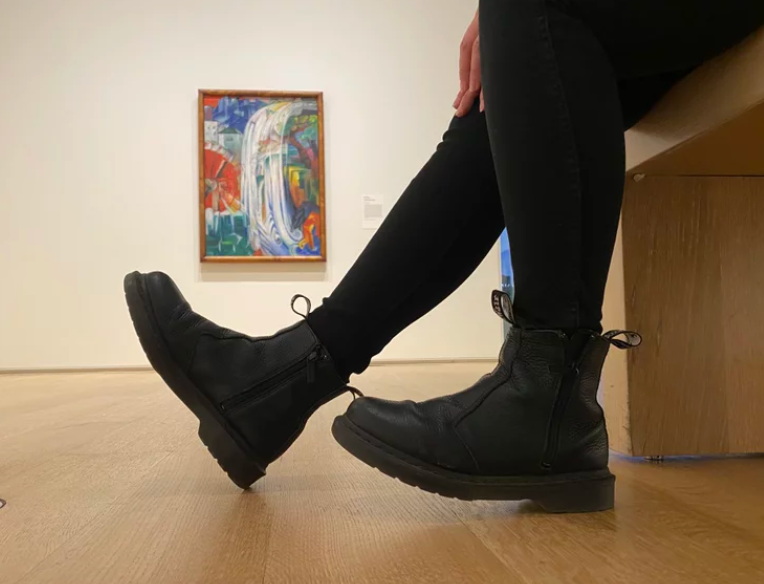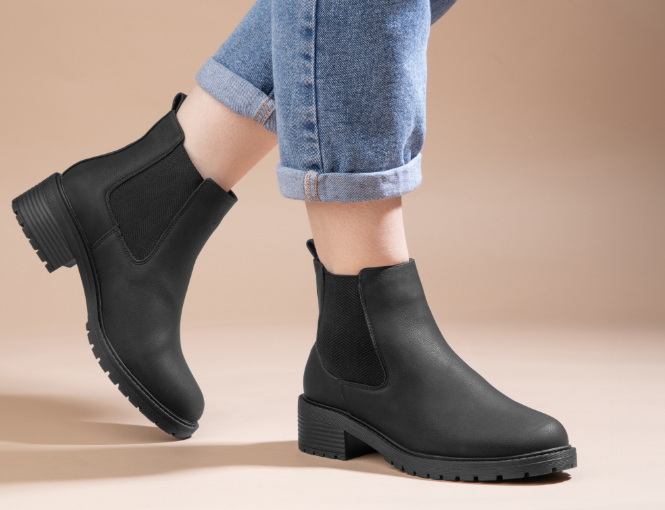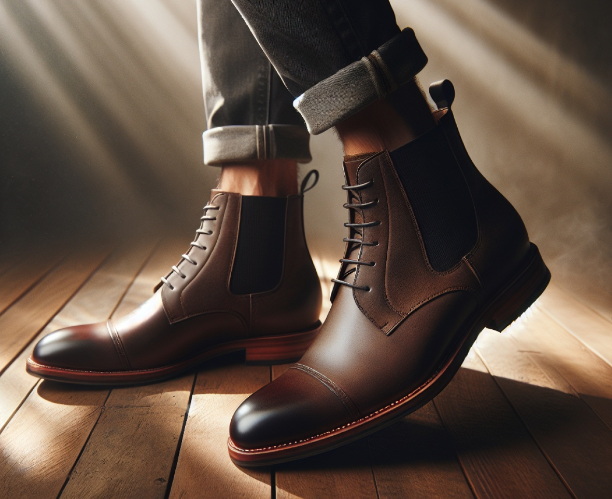Content Menu
● Understanding Chelsea Boots
● The Importance of Fit
● Key Elements of a Perfect Fit
>> 1. Snug Heel Fit
>> 2. Comfortable Toe Box
>> 3. Elastic Side Panels
>> 4. Ankle Fit
● How to Check for Fit
● Common Fit Issues and Solutions
● Styling Chelsea Boots
● Care Tips for Chelsea Boots
● When to Replace Your Chelsea Boots
● Conclusion
● FAQ
>> 1. How do I know if my Chelsea boots are too tight?
>> 2. Can I stretch my Chelsea boots if they are too tight?
>> 3. Should I buy Chelsea boots in my regular shoe size?
>> 4. What type of socks should I wear with Chelsea boots?
>> 5. Are there brands known for better-fitting Chelsea boots?
● Citations:
Chelsea boots are a timeless and versatile footwear choice that can elevate any outfit, from casual to formal. However, achieving the right fit is crucial for both comfort and style. This article will explore how tight Chelsea boots should be, the key elements of a perfect fit, and tips for ensuring your boots are snug without being too tight.

Understanding Chelsea Boots
Chelsea boots are characterized by their ankle-high design, elastic side panels, and pull-on style. They are often made from leather or suede and can be worn by both men and women. The unique design allows for easy on-and-off wear while maintaining a sleek silhouette.
The Importance of Fit
The fit of Chelsea boots is essential because it directly impacts comfort and appearance. A poorly fitted boot can lead to blisters, discomfort, and an unflattering look. Conversely, a well-fitted boot will feel snug yet comfortable, providing support while preserving the stylish profile that makes Chelsea boots so appealing.
Key Elements of a Perfect Fit
To determine how tight your Chelsea boots should be, consider the following key areas:
1. Snug Heel Fit
The heel should fit snugly against the boot without slipping out as you walk. A secure heel prevents irritation and blisters caused by friction. If you notice excessive movement at the heel, the boots may be too large. Conversely, if the heel feels pinched or overly tight, they may be too small.
2. Comfortable Toe Box
Your toes should have enough room to wiggle without feeling cramped. A good rule of thumb is to leave about a thumb's width of space between your longest toe and the front of the boot. If your toes feel pinched or hit the front of the boot when walking, it indicates that the boots are too tight.
3. Elastic Side Panels
The elastic side panels should provide a comfortable fit around your ankle without feeling constrictive. They should allow for easy entry and exit while ensuring that the boot remains secure on your foot.
4. Ankle Fit
Chelsea boots should fit snugly around the ankle with no gaps. Gaps can detract from their sleek appearance and lead to instability. Using a shoehorn when putting on your boots can help achieve a tighter fit around the ankle.
How to Check for Fit
When trying on Chelsea boots, keep these tips in mind:
- Wear Appropriate Socks: Always try on Chelsea boots with the type of socks you plan to wear regularly. Thicker socks may require going up half a size.
- Walk Around: Take a few steps in the boots to assess comfort and stability. Look for any discomfort or pinching.
- Check Toe and Heel Space: Ensure there is enough room in the toe box while also checking that your heel feels secure.
- Try Them Later in the Day: Your feet tend to swell throughout the day; trying on boots in the afternoon can help you find a more accurate fit.
Common Fit Issues and Solutions
If you find that your Chelsea boots are too loose or too tight, consider these solutions:
- If Too Loose: You can use tongue pads or insoles to fill extra space at the instep area of the boot. This adjustment helps secure your foot without compromising comfort.
- If Too Tight: If your Chelsea boots feel overly tight, consider stretching them slightly using professional stretching services or at-home methods like wearing thick socks while walking around your home.
Styling Chelsea Boots
The versatility of Chelsea boots makes them suitable for various occasions and outfits:
- Casual Wear: Pair them with jeans or chinos for a relaxed yet stylish look. A simple t-shirt or casual button-down shirt complements this outfit well.
- Formal Attire: For more formal settings, wear them with tailored trousers or suits. Opt for leather Chelsea boots in classic colors like black or brown for an elegant finish.
- Layering: During colder months, layer with tailored coats or trench coats to enhance your overall look while keeping warm.

Care Tips for Chelsea Boots
To maintain their appearance and longevity, follow these care tips:
- Regular Cleaning: Clean your Chelsea boots regularly using a soft brush or cloth to remove dirt and dust. For leather versions, use leather cleaner specific to your boot material.
- Conditioning: Apply leather conditioner periodically to keep leather soft and prevent cracking.
- Waterproofing: If you live in a wet climate or plan to wear your boots in rain or snow, consider applying a waterproofing spray designed for leather or suede.
- Proper Storage: Store your Chelsea boots in a cool, dry place away from direct sunlight. Use boot trees to maintain their shape when not in use.
When to Replace Your Chelsea Boots
Even with proper care, there comes a time when replacement is necessary:
- Visible Damage: Look for cracks in the leather or significant wear on the soles that cannot be repaired.
- Loss of Comfort: If your once-comfortable boots start causing discomfort despite proper fitting adjustments, it may be time for new ones.
- Style Changes: Fashion evolves; if your Chelsea boots no longer match your style preferences or wardrobe needs, consider updating them.
Conclusion
Finding the right fit for Chelsea boots is essential for both comfort and style. They should feel snug but not painfully tight, allowing for some wiggle room in the toes while keeping your heels secure. By understanding how Chelsea boots should fit and following these guidelines, you can ensure that you choose a pair that looks great and feels comfortable all day long.

FAQ
1. How do I know if my Chelsea boots are too tight?
If you experience pinching or discomfort in your toes or if your heel slips out while walking, your Chelsea boots may be too tight or too loose.
2. Can I stretch my Chelsea boots if they are too tight?
Yes, you can stretch leather Chelsea boots using professional services or by wearing thick socks around your home to gently stretch them over time.
3. Should I buy Chelsea boots in my regular shoe size?
Chelsea boot sizing can vary by brand; it's best to try them on with appropriate socks to ensure a proper fit.
4. What type of socks should I wear with Chelsea boots?
Choose socks that provide comfort without adding bulk; thicker socks may require going up half a size when trying on boots.
5. Are there brands known for better-fitting Chelsea boots?
Fit can vary significantly between brands; it's advisable to try different styles and widths to find what works best for your foot shape.
Citations:
[1] https://www.youtube.com/watch?v=V_AsxR9huX4
[2] https://www.portlandleathergoods.com/pages/mens-chelsea-boot-size-guide
[3] https://www.pavers.co.uk/blogs/how-should-chelsea-boots-fit
[4] https://vessi.com/blogs/the-forecast/how-should-chelsea-boots-fit-essential-guidelines-for-the-perfect-look-and-comfort
[5] https://chelseabootstore.com/size-guide/
[6] https://ahinsashoes.com/products/womens-comfort-shoes-chelsea-2-brown
[7] https://ca.vessi.com/blogs/the-forecast/how-should-chelsea-boots-fit-essential-guidelines-for-the-perfect-look-and-comfort
[8] https://www.ahume.co.uk/blog/chelsea-boots-the-ultimate-buyers-guide/
[9] https://www.nextdirect.com/hk/en/style/su286801/b62102
[10] https://www.reddit.com/r/malefashionadvice/comments/5g4bdj/just_bought_a_pair_of_chelsea_boots_not_sure_how/
[11] https://www.reddit.com/r/Boots/comments/18fzehu/chelsea_boots_sizing/
[12] https://www.reddit.com/r/AustralianMFA/comments/1ez0fzi/chelsea_boots_with_comfort_as_1_priority_for_lots/
[13] https://www.rydale.com/blogs/news/how-should-chelsea-boots-fit
[14] https://www.rmwilliams.com/footwear/men/chelsea-boots?lang=en_US
[15] https://www.gaborshoes.co.uk/blog/2023/12/how-should-chelsea-boots-fit-a-complete-comfort-guide/
[16] https://www.next.ro/en/shop/gender-women-productaffiliation-footwear/category-boots-style-chelsea
[17] https://www.shoezone.com/Blog/the-low-down-on-chelsea-boots
[18] https://wydrstudios.com/collections/chelsea-boots
[19] https://www.cheaney.co.uk/blog/3-ways-to-effortlessly-style-mens-chelsea-boots/
[20] https://www.frau.it/eu/leather-chelsea-boots-with-shaded-finish-2-21196.html

















